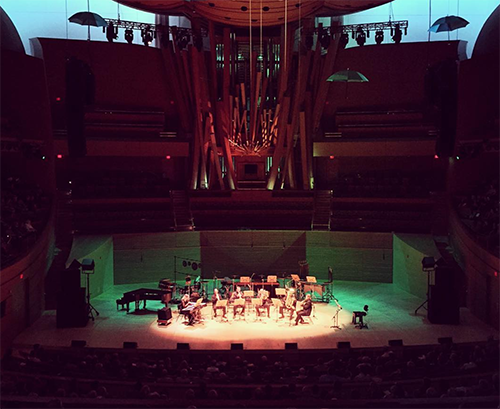
third movement
The three movements of “Lightmass” evoke living architectures and urban spaces – outward manifestations of inner experience, a living building as a divine body. The first movement can be equated with a gothic cathedral (St. John the Divine, NYC), with music evoking an organ, ecstatic plainchant, stained glass windows, and many different kinds of shimmering light. The contrasting second movement evokes imposing modern and art deco architecture, ancient pyramids, aerodynamic curves, the metallic steel of skyscrapers, and the contemplative awe of expansive urban landscapes. The third movement is transformational, and begins with chant-like sounds evoking playful dancing light, and the heaviness of stone. Following this introduction, a repetitive and ritualistic chant-like passage is gradually transformed into a much more fluid sense of time, where different types of musical material co-exist with one another. A confluence of green spaces, deep breathing, the inner radiance of hard matter, shimmering light, and subterranean depths. At the premiere, the composer John Adams praised the work’s “stentorian gestures”.
Sanctuary marked a new direction in my work, in that it more fully embraces the riff-oriented repetition present in my solo electronic and metal music, combined with my roots in modernist, spectralist, and minimalist approaches to modern classical composition. Sanctuary is a word derived from the latin Sanctuarium, literally meaning a “container” for holy things (sancta or sancti). Over time the meaning was extended to include places of safety, where one was safe from arrest due to the laws of the church. Architecturally, it can refer to a specific place around an altar in a Christian church, an intermediary or threshold space inhabited by divine presence, namely where the eucharist or divine body is received. Anthropologist Marcio Goldman, in his writing on the Afro-Brazilian religion of Candomble, distinguishes between cosmological systems (i.e. mappings of divine and human worlds, virtual and real worlds) and the actions the cosmology allows practitioners to produce. That learning a religion like Candomble, “cannot mean passive apprehension but rather an experience that modifies all of the elements involved in that process – the matter being ‘transmitted’ and ‘assimilated’, but also the agents or subjects who…are engaged in an ongoing transformational process.” In this work, I seek to explore the idea of a sanctuary as a space to enable action, and spiritual practice as a technology for transforming the self and the senses. The musicians of TAK engage in sonic actions, transformational processes, and negotiations with virtuality. The sensory elements present in this work; sound and light relationships, acoustic and electronic sound, stark rhythms and ecstatic gestures, may suggest ways of navigating threshold spaces, cultivating sanctuaries of interdependency, connectedness, and power.
third movement